
Thanks to Jane at yarnstorm
my investigation into Saucer Cheese Cake
has been taken a step further
to Mrs Beeton's recipe for Saucer Cake.


 Shauna over at Cooking with Ginger reports on how the Mothership kept only healthy food in the house. This brought back memories for me. I get a hard time from my 30 something and 40 something kids. Thick slices of homemade wholemeal bread in school lunches. The plastic garbage bins in the kitchen with wholemeal flour and raw sugar. But there was the greatest child abuse of all - Coco Pops deprivation. The cereals in our house were Vita Brits, Weet Bix, Corn Flakes, Rice Bubbles and Uncle Toby's Oats. Coco Pops (their favourite) and Fruit Loops were treats for Christmas and Easter. Even now, Coco Pops puts in an appearance in my daughter's pantry. Oh, the scars of deprivation!
Shauna over at Cooking with Ginger reports on how the Mothership kept only healthy food in the house. This brought back memories for me. I get a hard time from my 30 something and 40 something kids. Thick slices of homemade wholemeal bread in school lunches. The plastic garbage bins in the kitchen with wholemeal flour and raw sugar. But there was the greatest child abuse of all - Coco Pops deprivation. The cereals in our house were Vita Brits, Weet Bix, Corn Flakes, Rice Bubbles and Uncle Toby's Oats. Coco Pops (their favourite) and Fruit Loops were treats for Christmas and Easter. Even now, Coco Pops puts in an appearance in my daughter's pantry. Oh, the scars of deprivation!
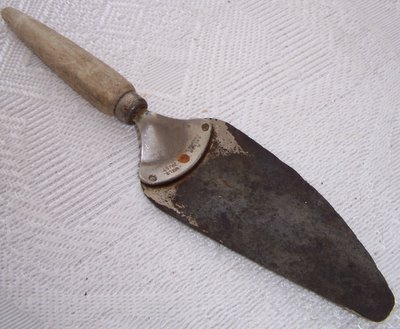 My copy of the Concise Oxford Dictionary defines a spatula as a broad-bladed instrument for working pigments, picking up powder, etc; a surgeon's instrument for pressing tongue down or to one side. This is used for cooking purposes. I have had it for more than forty years. The handle used to be a bright red but the paint has worn away. You can just see the remnants of the silvery metal that covered the blade but it too has worn away over nearly half a century. Do they still make spatulas like this? When pressure is applied to the handle there is a bit of a spring which is valuable when aerating a mixture.
I use my spatula for two purposes - one for turning and lifting pikelets and pancakes; and the second for folding flour into the egg mixture when making a sponge cake. This was a tip that came with the sponge cake recipe. The springiness of the spatula folds air in with the flour making for lightness in the sponge.
My spatula started life in Bowen, moved with me to Toowoomba, travelled half way around Australia on a working holiday with me, a husband, three kids and a cat in a 23 foot caravan pulled by a four-ton double-cab Bedford truck. It settled in Mount Isa, went to Townsville, then to Tennant Creek, followed by Sydney, Walgett, Townsville again and now Melbourne. It learned to make sponge cakes to satisfy a husband spoiled by his mother's wonderful sponges. It made two very large heart shaped cakes for my daughter's wedding. And plates and plates of pikelets and pancakes.
My copy of the Concise Oxford Dictionary defines a spatula as a broad-bladed instrument for working pigments, picking up powder, etc; a surgeon's instrument for pressing tongue down or to one side. This is used for cooking purposes. I have had it for more than forty years. The handle used to be a bright red but the paint has worn away. You can just see the remnants of the silvery metal that covered the blade but it too has worn away over nearly half a century. Do they still make spatulas like this? When pressure is applied to the handle there is a bit of a spring which is valuable when aerating a mixture.
I use my spatula for two purposes - one for turning and lifting pikelets and pancakes; and the second for folding flour into the egg mixture when making a sponge cake. This was a tip that came with the sponge cake recipe. The springiness of the spatula folds air in with the flour making for lightness in the sponge.
My spatula started life in Bowen, moved with me to Toowoomba, travelled half way around Australia on a working holiday with me, a husband, three kids and a cat in a 23 foot caravan pulled by a four-ton double-cab Bedford truck. It settled in Mount Isa, went to Townsville, then to Tennant Creek, followed by Sydney, Walgett, Townsville again and now Melbourne. It learned to make sponge cakes to satisfy a husband spoiled by his mother's wonderful sponges. It made two very large heart shaped cakes for my daughter's wedding. And plates and plates of pikelets and pancakes.
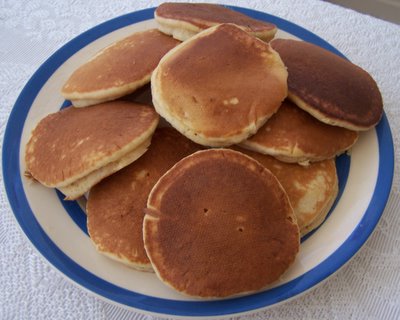 My mother, Phyll O'Carroll, once cooked so many pikelets for a church fete that she was thereafter known as Mrs O'Pikelet. Back in the 1950s she found the recipe in Brisbane's The Courier Mail. Pikelets can be eaten as is but are usually served with butter and honey or butter and jam and whipped cream. My favourite jam on pikelets is blackcurrant. Lovely for a ladies afternoon tea when you get out your pretty china with the pink roses. The recipe:
My mother, Phyll O'Carroll, once cooked so many pikelets for a church fete that she was thereafter known as Mrs O'Pikelet. Back in the 1950s she found the recipe in Brisbane's The Courier Mail. Pikelets can be eaten as is but are usually served with butter and honey or butter and jam and whipped cream. My favourite jam on pikelets is blackcurrant. Lovely for a ladies afternoon tea when you get out your pretty china with the pink roses. The recipe:
 Two favourite things on my cookbook shelves are classics by Rosemary Hemphill. Rosemary Hemphill was born on 1 April 1922, in Broome in the north-west of Western Australia. Her childhood was divided between Broome and Bromley, England, where her love of gardens and all things green was born. Together with her husband, Rosemary established Australia’s first herb-growing business, Somerset Cottage. The buff covered book is Fragrance and Flavour: the growing and use of herbs. It is decorated with illustrations by Pixie O'Harris, the aunt of Australian entertainment icon, Rolf Harris. The pink dust-jacket is particularly treasured because it is a first edition. It is titled Spice and Savour: cooking with dried herbs, spices, and aromatic seeds. Illustrations in this book are by Claire Simpson.
Rosemary and her husband John introduced Australians to herbs and showed us how to enjoy their flavour and to include them in our food. Prior to this, Australians used to rely heavily on Mixed Herbs, a dry and nameless concoction with no subtlety. I still keep a container that I use once or twice a year. I have to confess I love Mixed Herbs in my poultry stuffing. Fragrance and Flavour was awarded a diploma and a bronze medal in the literary competition held at Frankfurt-am-Main in October 1960 on the occasion of the International Exhibition of Culinary Arts.
Rosemary and John's son Ian and his wife Liz continue the tradition. Ian and Liz run Herbie's Spices at Rozelle in Sydney. Herbie's Spices has expanded greatly in recent years and they are now invading supermarkets and the hoi polloi can have access to them not just the trendy basket weavers of Balmain and Rozelle.
Two favourite things on my cookbook shelves are classics by Rosemary Hemphill. Rosemary Hemphill was born on 1 April 1922, in Broome in the north-west of Western Australia. Her childhood was divided between Broome and Bromley, England, where her love of gardens and all things green was born. Together with her husband, Rosemary established Australia’s first herb-growing business, Somerset Cottage. The buff covered book is Fragrance and Flavour: the growing and use of herbs. It is decorated with illustrations by Pixie O'Harris, the aunt of Australian entertainment icon, Rolf Harris. The pink dust-jacket is particularly treasured because it is a first edition. It is titled Spice and Savour: cooking with dried herbs, spices, and aromatic seeds. Illustrations in this book are by Claire Simpson.
Rosemary and her husband John introduced Australians to herbs and showed us how to enjoy their flavour and to include them in our food. Prior to this, Australians used to rely heavily on Mixed Herbs, a dry and nameless concoction with no subtlety. I still keep a container that I use once or twice a year. I have to confess I love Mixed Herbs in my poultry stuffing. Fragrance and Flavour was awarded a diploma and a bronze medal in the literary competition held at Frankfurt-am-Main in October 1960 on the occasion of the International Exhibition of Culinary Arts.
Rosemary and John's son Ian and his wife Liz continue the tradition. Ian and Liz run Herbie's Spices at Rozelle in Sydney. Herbie's Spices has expanded greatly in recent years and they are now invading supermarkets and the hoi polloi can have access to them not just the trendy basket weavers of Balmain and Rozelle.
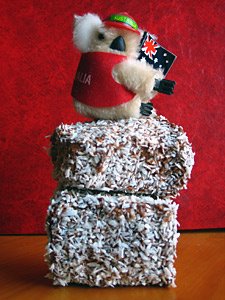 Pop over here to an expat Aussie's food blog.
Pop over here to an expat Aussie's food blog.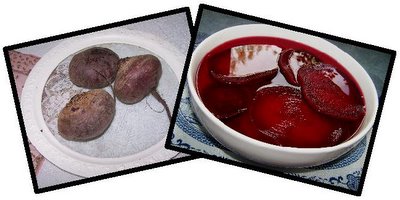 Integral to a good Australian salad is beetroot. I don't know if Australian beetroot is the same as what the U.S. calls beets. Perhaps it's not. You see in the Land of Oz beetroot has come to define responsiveness to Australian tastes in American fast foods. Maccas and Hungry Jacks (Burger Chief in the U.S.) put beetroot on hamburgers to satisfy Australians. However, there is a rising underswell of resentment against Subway who refuse to respond. Over at An Aussie in America, Stuart from Western Australia (WA) is having a big whinge. If you pop over here you will find a quite graphic expression of pro-beetroot resentment against Subway. Anyway, here is beetroot the Australian way. This is the way my mother, Phyllis, used to do it.
Integral to a good Australian salad is beetroot. I don't know if Australian beetroot is the same as what the U.S. calls beets. Perhaps it's not. You see in the Land of Oz beetroot has come to define responsiveness to Australian tastes in American fast foods. Maccas and Hungry Jacks (Burger Chief in the U.S.) put beetroot on hamburgers to satisfy Australians. However, there is a rising underswell of resentment against Subway who refuse to respond. Over at An Aussie in America, Stuart from Western Australia (WA) is having a big whinge. If you pop over here you will find a quite graphic expression of pro-beetroot resentment against Subway. Anyway, here is beetroot the Australian way. This is the way my mother, Phyllis, used to do it.
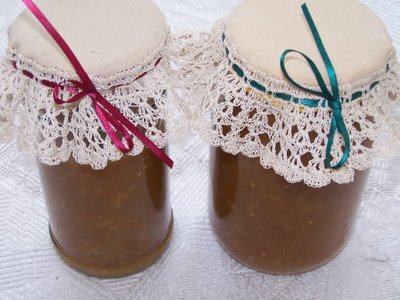 I grew up in Bowen, at the northern end of The Whitsundays in North Queensland, which is the winter tomato capital of Australia. The crop is croppin' and so it is Tomato Relish time. The recipe comes from the Bowen Methodist Ladies Cook Book which I acquired as a new bride back in the '60s. That cook book has long since disintegrated - it was roneo-d long before the advent of photocopiers. Even the Methodist Church does not exist. It joined with the Presbyterians and the Congregationalists to form the Uniting Church. The recipe continues now in my hand written cookbook - once-bound but now loose-leafed - and on this blog and hopefully into the recipe books of others. This relish was made from my crop of yellow tomatoes. Red tomatoes make a red relish. Yellow tomatoes make a brown relish - but just as tasty and yummy. This relish is great on cold meats, bread and butter, or mashed potatoes.
I grew up in Bowen, at the northern end of The Whitsundays in North Queensland, which is the winter tomato capital of Australia. The crop is croppin' and so it is Tomato Relish time. The recipe comes from the Bowen Methodist Ladies Cook Book which I acquired as a new bride back in the '60s. That cook book has long since disintegrated - it was roneo-d long before the advent of photocopiers. Even the Methodist Church does not exist. It joined with the Presbyterians and the Congregationalists to form the Uniting Church. The recipe continues now in my hand written cookbook - once-bound but now loose-leafed - and on this blog and hopefully into the recipe books of others. This relish was made from my crop of yellow tomatoes. Red tomatoes make a red relish. Yellow tomatoes make a brown relish - but just as tasty and yummy. This relish is great on cold meats, bread and butter, or mashed potatoes. The pretty little vignette above was part of the centrepiece in a table-setting challenge set by Jennifer at The Felt Mouse. You can read all about it at The Trad Pad. The cup and saucer are plain glass I've decoupaged with rice paper and a pretty rose. Around the saucer are some of Mac's Macadamia Butter Melts and in the cup are some green and white boiled lollies known to some as "rock candy". I am rather proud of the Macadamia Melts. In this globalized world, the Melts have that wonderful ingredient, the Macadamia Nut, which is an Australian native and was, before commercialization, known as the Queensland Nut. The Melts come from Mac's Shortbread Company in Kerang here in Victoria. A beautiful melt in your mouth product that is still home-grown and home-made.
The pretty little vignette above was part of the centrepiece in a table-setting challenge set by Jennifer at The Felt Mouse. You can read all about it at The Trad Pad. The cup and saucer are plain glass I've decoupaged with rice paper and a pretty rose. Around the saucer are some of Mac's Macadamia Butter Melts and in the cup are some green and white boiled lollies known to some as "rock candy". I am rather proud of the Macadamia Melts. In this globalized world, the Melts have that wonderful ingredient, the Macadamia Nut, which is an Australian native and was, before commercialization, known as the Queensland Nut. The Melts come from Mac's Shortbread Company in Kerang here in Victoria. A beautiful melt in your mouth product that is still home-grown and home-made. 